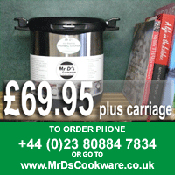 A mussaman curry is one of the most delicious dishes. It is thought to have arrived in Siam with the first Persian envoy to the court of Ayuthyia in the sixteenth century. Mr D has adapted this recipe for the Shuttle Chef from one published in Fresh Magazine and they have kindly given their permission for us to use it. This unusual version of Thai mussaman curry is highly seasoned with tamarind and will delight you and your guests.
A mussaman curry is one of the most delicious dishes. It is thought to have arrived in Siam with the first Persian envoy to the court of Ayuthyia in the sixteenth century. Mr D has adapted this recipe for the Shuttle Chef from one published in Fresh Magazine and they have kindly given their permission for us to use it. This unusual version of Thai mussaman curry is highly seasoned with tamarind and will delight you and your guests.INGREDIENTS:
- large duck breasts
- 2 star anise
- 2" piece of cinnamon stick
- 3 bay leaves
- 6 cardamom pods
- 1 large onion chopped
- 3tbs Mussaman paste
- 400ml coconut milk
- 200ml water & 1 chicken stock cube
- small jar 100gm tamarind paste
- 1tbs fish sauce
- 75g salted peanuts
- 350g potatoes cut into 2.5cm cubes
- small bunch of coriander leaves
- Put a frying pan on a high heat and when hot add the two duck breasts skin side down. Cook for 5-6 minutes until the skin is golden brown.
- Turn the breasts over and cook for a further minute.
- Remove from the pan slice the duck breasts and put to one side for later.
- Heat 2 tbsp of oil in the shuttle chef inner pot over a medium heat.
- Add the star anise, cinnamon, bay leaves and cardamom and cook for 30 secs.
- Add the chopped onion and cook for 4-6 minutes until golden.
- Stir in the Mussaman paste and cook for 1 minute.
- Add the sliced duck and make sure that it well coated with the mixture. Cook for 2 minutes.
- Add the cocunut milk, tamarind and fish sauce.
- Add the chopped potatoes and make sure that they are nicely covered with the sauce. Bring to the boil.
- Add 3/4 of the peanuts (saving the rest for garnish).
- Turn the heat down to a simmer and cook for 5 minutes.
- Put the lid on the inner pot and place it into the insulated outer pot.
- Put the lid down and leave it to cook for 2 hours.
- Serve with Jasmine rice and garnish with the remaining peanuts and the coriander.










.jpg)
-01.jpg)
-Fruit-C.jpg)



